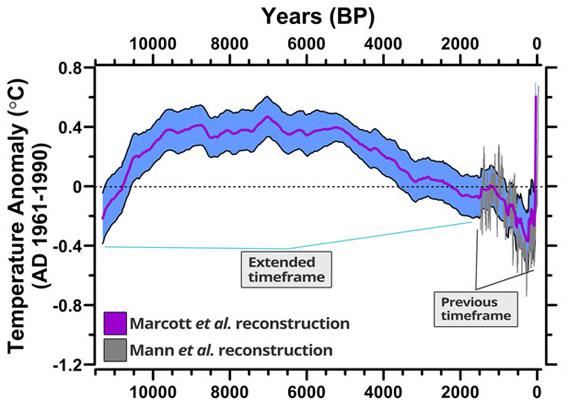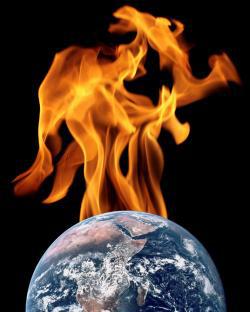(Or, “Misfire When Ready, Ridley”)
Arguing with deniers of any stripe gets tiresome quickly. They trot out old, already-debunked points, misuse known science, or sow confusion where none exists. Countering their nonsense is like trying to dig a hole in water.
Sometimes, though, events conspire such that it has to be done. So here we go again, again.
A recap: Last week, Matt Ridley wrote an opinion piece about global warming for the Wall Street Journal, saying that he doesn’t think the science supports any real concern about it. He used a couple of pieces of evidence to back up his claims, both of which were wrong.
So earlier this week I posted about it, debunking his claims. In a nutshell, the evidence he cited was hot air (ha! haha!) from denier blogs and not from peer-reviewed scientific journals. I went to the website Skeptical Science—which does use peer-reviewed scientific journals—to show just how and where Ridley was wrong.
Shortly thereafter, on the same day, Ridley posted a counter-rebuttal on his blog, the Rational Optimist, which has also been reposted in the WSJ. In it, he basically takes aim once again at his own foot (it seems to be his modus operandi). In the same breath as calling my knowledge of the literature superficial, he again goes to denier blogs and a newspaper editorial page (seriously!), not scientific journals, to make his point (although, to be fair, for some odd reason, there don’t seem to be too many denial papers published in actual journals). And again, he is wrong.
You’d think by now these kinds of folks would learn. Oh, wait. No you wouldn’t.
I’ll note these topics can be complex, but I’ll try to be brief and still explain the meaty bits, because this is important.
Carbon Dioxide and Temperature
Looking at changing levels of carbon dioxide in Earth’s atmosphere and temperatures in the deep past, it’s clear that they’re related. In his original WSJ article Ridley argues that at the ends of previous ice ages, temperatures went up before CO2 levels did, and therefore (as Ridley concludes) CO2 rise isn’t as big a deal as climate scientists think. In my article, I point out he’s wrong: Relatively small rises in temperature increase the CO2 in the air, which (because it’s a greenhouse gas) then increases temperatures by a lot more. Eventually this situation stabilizes, but in general, higher temperatures follow higher levels of CO2 in the air.
In his rebuttal, Ridley tries to make hay of the CO2 levels falling in the past after temperatures already began to fall (and another point in time when CO2 went up even though temperatures stayed relatively flat). But what Ridley assumes is that scientists think that only CO2 can affect temperature, and that it happens right away. But that’s not the case; of course there are other factors that can drive temperatures, such as the Milankovitch cycles (changes in the Earth’s orbit).
But look at the timescales. In the past, we’re talking changes over many thousands or tens of thousands of years, with slowly increasing levels of CO2 in the air. That’s plenty of time for other factors to come into play, and it’s not terribly relevant to what’s going on right now, today, as we increase the amount of CO2 in the air far, far faster than has ever been seen in the ancient records. This wholly unnatural increase is driving temperature so quickly that other, slower factors don’t have time to play out. Using ancient records to understand what’s happening today is useful, but it’s not a one-to-one comparison.
And even then, once CO2 gets past a certain amount, it tends to dominate the game over those other forces. It’s clearly doing that today.
The RealClimate site—written by working professional climate scientists—has a good article about the relationship between CO2 and temperatures. They discuss a paper by Caillon et al. that shows how CO2 rise can lag temperature, but then that small increase in CO2 itself drives the larger temperature rise. Skeptical Science has more details, discussing a paper by Shakun, et al. (titled, oddly enough, “Global warming preceded by increasing carbon dioxide concentrations during the last deglaciation” [emphasis mine]), which shows that this can be complex. But overall, both show that most of the temperature increase follows a rise in CO2 (a whopping 93 percent of the time).
Mind you, again, we’re talking natural variations here that take millennia, not the current rapid warming that has been unbalanced by human activities. Also note that I’m quoting work done by actual climate scientists. Ridley quoted a denial blog post written by Willis Escherbach (who is not a climate scientist), and whose claims in that post have been thoroughly debunked at—you guessed it—Skeptical Science. In fact, his writing has had to be debunked there many, many times.
The Blade of the Hockey Stick
This is my favorite part. Ridley claims the Marcott et al. hockey-stick diagram has been discredited (quoting as evidence—get this—the Financial Post newspaper op-ed section, a bastion of fact-free climate change denial). Ridley even says the authors of the graph themselves discredit it! But there’s a problem: He’s wrong, and he’s quote mining, a tactic used by deniers to make it seem like someone is saying something they’re not.
I literally laughed when I read that part of Ridley’s rebuttal. As I point out in detail in my other post, the original hockey-stick diagram by Mann (1999) has been verified over and over again (including by a paper that came out just a couple of months ago, and which is analyzed at Climate Progress by yet another professional climatologist). Despite the deniers trying desperately to tear it down, it keeps on keeping on.

Graph by Marcott et al. (via Climate Desk)
And Ridley’s dismissal of Marcott’s graph is very, very misleading. He tries to show that the graph is invalid by quoting the authors:
“[The] 20th-century portion of our paleotemperature stack is not statistically robust, cannot be considered representative of global temperature changes, and therefore is not the basis of any of our conclusions.”
Sounds bad, doesn’t it? But why would the authors say such a thing in their own paper?
Because they knew the methods they used in their research to measure temperatures in the distant past wouldn’t work for modern times (due to the way they smoothed their data). So, as good scientists, they made it clear that part of their data wasn’t reliable, and didn’t use it in their conclusions. Instead, they use actual measured temperatures for the past century or so to make their conclusions. Hello.
Because their work was being so badly abused by deniers (imagine that!), all four of the authors of that paper were moved to post a detailed rebuttal on RealClimate. As they themselves say (again, emphasis mine):
Our primary conclusions are based on a comparison of the longer term paleotemperature changes from our reconstruction with the well-documented temperature changes that have occurred over the last century, as documented by the instrumental record.
That’s a bit different than how Ridley makes it sound, isn’t it? Ridley’s dismissal of the graph is debunked in that RealClimate article by the authors, so go there to see why he’s so very wrong. As usual, you can get more details on Skeptical Science, which debunks Ridley’s points even further.
Hot enough for you?
I found Ridley’s rebuttal to be pretty weak, which is no surprise; the scientific evidence for global warming is overwhelming, the consensus among climate scientists nearly universal because of that, and most real skeptics have long since understood that. And despite Ridley’s attempts to downplay it, scientists know the current rapid rise in temperature is bad and is very likely to make things much worse for us in the future.
Because Ridley says he thinks CO2 does cause some warming and that humans are behind some of that, he claims he’s not a denier. But the thing is, he uses shaky arguments, points to denier blogs as evidence, denies that global warming is bad, and downplays its repercussions despite all the evidence. In my opinion, that makes him a denier. Others agree, and his history on the topic speaks for itself.
A personal note: Writing this kind of thing brings me no joy. I don’t want the world to be warming, I don’t want our climate to be changing, I don’t want to see more drought and fires and extreme weather—I’ve had quite enough of all of that in my home state of Colorado, thank you. But that’s the reality we face, and to deny it is more than just foolish. It’s dangerous. Honestly, I’d rather be telling you about the glory of the Universe and how science has shown us and continues to show us how it works. Instead, though, I have to spend time playing whack-a-mole with anti-science.
Yet it has to be done. That’s too bad, but—and I do see the irony here—that’s reality.
Tip o’ the calving glacier to climatologist Michael Mann for sending me a couple of the links appearing in this article.
